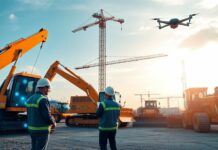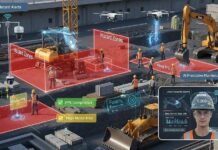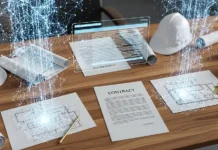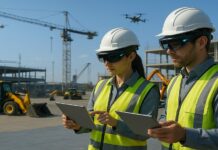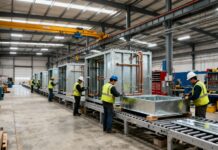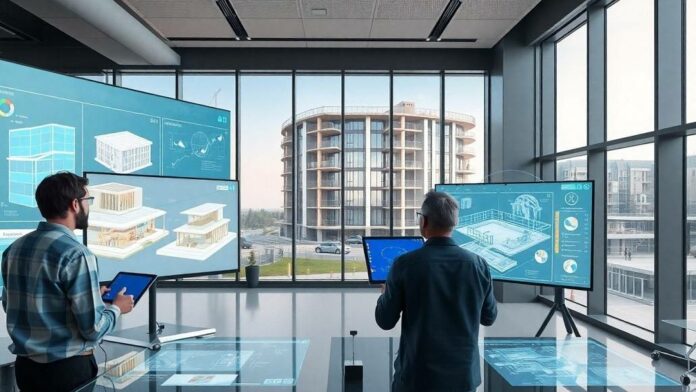The architectural world has long been driven by creativity, precision, and the capacity to envision and construct spaces that inspire and serve humanity. However, the integration of artificial intelligence is redefining this discipline, pushing the boundaries of what is possible. From quicker proposals than ever before to streamlining construction, AI is revolutionizing the manner in which architects create and build.
AI’s ability to process vast amounts of data, identify patterns, and make predictions has introduced efficiency and accuracy into architectural workflows. AI not only boosts creativity, but it also helps people make better decisions based on data that takes into account the environment, cost estimations, and long-term sustainability. AI’s ability to learn, improve its skills, and adapt has made it an essential tool for architects. It has changed everything from coming up with ideas to building things.
The Role of AI in Generating Faster Proposals
Proposal creation is a crucial step in architectural design, as it takes vague concepts and converts them into real plans addressing customer requirements and project constraints. Conventional proposal creation has been a time-consuming endeavor, where architects will create several ideas by hand, collect information, and improve upon concepts. AI, in contrast, brought about a revolution by speeding up the process.
AI-based software can review project specifications, site information, and zoning laws within minutes. Using machine learning algorithms, the systems are able to create design proposals that meet precise requirements of clients, including spatial efficiency, esthetic values, and ecological considerations. AI can iterate through hundreds of design alternatives, enabling architects to view an extensive list of options without having to spend hours of human effort.
Customization is another major benefit of AI. AI systems can integrate client preferences to generate customized proposals. For example, if a client values sustainability, AI may optimise designs for energy efficiency and environmental performance by considering elements such as solar access, wind flow, and material choice. This guarantees that bids are as per the client’s demands while being project appropriate.
Optimising Smarter Builds with AI
While AI’s function in speeding up proposals is revolutionary, its impact extends far beyond the initial design stage to construction and project implementation. AI enables improved building through predictive analysis, resource utilisation, and real-time tracking.
Predictive analytics with AI allows construction managers and architects to anticipate hazards in the construction process. AI uses past data and project parameters to predict cost overruns, material shortages, and timetable delays. This forecast allows for proactive decision-making to ensure that projects are finished on schedule and within budget.
Another area where AI excels is in resource optimisation. Construction involves managing a wide range of resources, from materials to personnel. AI systems may assess site circumstances and logistical constraints to optimise resource supply and allocation, hence minimising waste and inefficiency. For example, AI can determine the best sequence for assembling prefabricated components, making assembly easier.
Real-time tracking using IoT sensors and AI algorithms encourages responsibility and quality control on construction sites. Such technologies provide updates on construction progress, detect deviations from the blueprint, and ensure compliance with safety regulations.
AI in Sustainability and Smart Building Design
Sustainability is at the forefront of today’s architecture, and AI is critical to achieving green building goals. AI allows architects to create buildings that are not only energy efficient and environmentally conscious, but also future-proof.
AI approaches can simulate and model the environmental consequences of design decisions. For example, AI may examine how building orientation, window placement, and material usage affect energy consumption. By stimulating these, architects may make informed decisions that reduce a building’s carbon footprint and operational costs, therefore reducing the overall costs.
Sustainable building design, powered by AI, takes the next level. Lighting sensors, HVAC control, and energy monitoring devices are examples of smart building systems that can be automated using artificial intelligence. The systems employ occupant behaviour and ambient information to optimise energy use in real time. AI can assist in estimating the maintenance requirements for building systems, assuring long-term efficiency and reducing expenses.
The Collaborative Power of AI in Architecture
AI is not a replacement for human imagination, but rather a tool that enhances an architect’s creativity. AI frees architects to engage on higher-order design problems such as developing environments that elicit feelings and foster community by automating monotonous chores and generating data insights.
AI-human collaboration expands to cross-disciplinary project teams. Engineers, contractors, and environmental specialists can share their cumulative AI-driven insights on a single platform, ensuring that all stakeholders are on the same page throughout the project’s life cycle. AI’s open ecosystem promotes integrated solutions that consider technical, social, and environmental factors.
The incorporation of AI in architectural design also democratizes architecture. AI systems reduce the entry barrier for small practices and individual architects, making resources and computational power available that were hitherto the prerogative of large organizations. Democratization leads to diversity and innovation in the world of architecture.
Challenges and Ethical Considerations
Despite its transformational potential, AI in architecture presents hurdles. Over-reliance on AI-generated solutions may limit originality and create homogeneous designs, raising concerns. Architects must strike a balance between exploiting AI’s capabilities and maintaining the human touch that distinguishes meaningful architecture.
Data security and privacy are also serious issues. AI systems need access to large datasets, potentially containing sensitive data regarding clients, projects, or sites. Protection of data and its proper use are essential to ensure trust and accountability within the industry.
Furthermore, the application of AI within architectural processes involves investment in training and infrastructure. Designers and architects require new skills to effectively utilize AI tools, whereas companies need to invest in computational powers and software platforms.
Future Trends in AI-Driven Architecture
The future of AI technology in building design is characterized by thrilling trends that will propel the profession to unprecedented heights. One of them is the utilization of generative design, in which AI programs produce design options based on predetermined objectives and limitations. This is a method through which architects can investigate out-of-the-box solutions and extend creativity limits.
Another trend in the making is the convergence of AI with virtual reality (VR) and augmented reality (AR). These technologies allow architects to experience and engage with designs in interactive environments, improving communication with stakeholders and clients.
The application of AI in urban planning is also increasing. Through analyzing population statistics, traffic flows, and environmental conditions, AI can help architects design smart cities that maximize growth and combine it with sustainability and livability.
Conclusion
AI is revolutionising the way architects work by making proposals faster and projects smarter so they can keep up with a world that is changing quickly. It helps them make proposals quicker and projects smarter to keep pace with a fast-changing world. In their work, architects can use AI to boost creativity, productivity, and sustainability. This leads to solutions that benefit clients, communities, and the environment.
As technology improves, AI will increasingly take center stage in defining the future of architecture. The synergy of human creativity and the computational capabilities of AI holds the promise of opening up new frontiers, ranging from designing carbon-zero buildings to developing adaptive buildings that learn to respond to the needs of their occupants.
Architects can make the most of what is possible by using this cutting-edge technology. This will let the built environment change and respond to the challenges and opportunities of today. AI in architecture is more than simply a tool; it sparks new ideas, makes it easier for people to work together, and pushes progress. Architecture in the future will not only be smart, but also more welcoming, caring for the environment, and inspiring.









